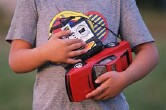
FRIDAY, June 3 (HealthDay News) — Providing children with more toys to play with may improve their level of physical activity, researchers say.
The new study also found that having more active toys to choose from boosts the intensity of play among children, particularly girls.
In the study, led by Denise Feda, postdoctoral associate at the University of Buffalo in New York, researchers offered three different quantities of toys to 36 children ranging in age from 8 to 12 years. After being given one, three or five toys to play with, the children’s behaviors, heart rates and activity counts were monitored for one hour.
The investigators found that overall playtime jumped by 95 percent among the children who had three or five toys. Gender also came into play. The heart rate data collected by the researchers revealed that girls given more toys played with greater intensity than boys with the same number of choices.
The report did not specify what types of toys were used.
Children and adolescents should participate in at least one hour of physical activity each day, according to the American College of Sports Medicine (ACSM) and the Physical Activity Guidelines for Americans. The study authors pointed out that their findings could help children reach this goal.
“The results of this study are significant, considering the epidemic of childhood obesity plaguing this country,” Feda said in an ACSM news release. “Adults looking for effective ways to increase their child’s exercise time should take a look at toy variety. Adding an active toy or two could help, especially for girls. Girls can be motivated to engage in equal physical activity as boys by simply providing them with a greater choice of active toys,” she concluded.
The findings were to be presented this week at the American College of Sports Medicine annual meeting, held in conjunction with the World Congress on Exercise Is Medicine, in Denver. Experts note that research presented at meetings isn’t subjected to the same type of scrutiny given to research published in peer-reviewed journals.
More information
Visit the American Academy of Pediatrics for more about the prevention and treatment of childhood obesity.

